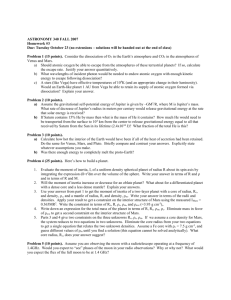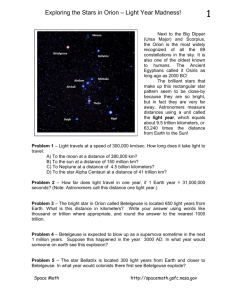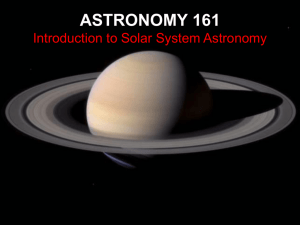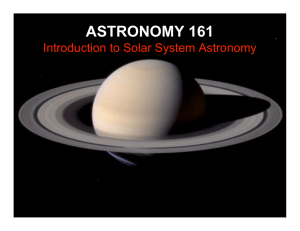Physics 306, Honors Astronomy, Exam 1
advertisement
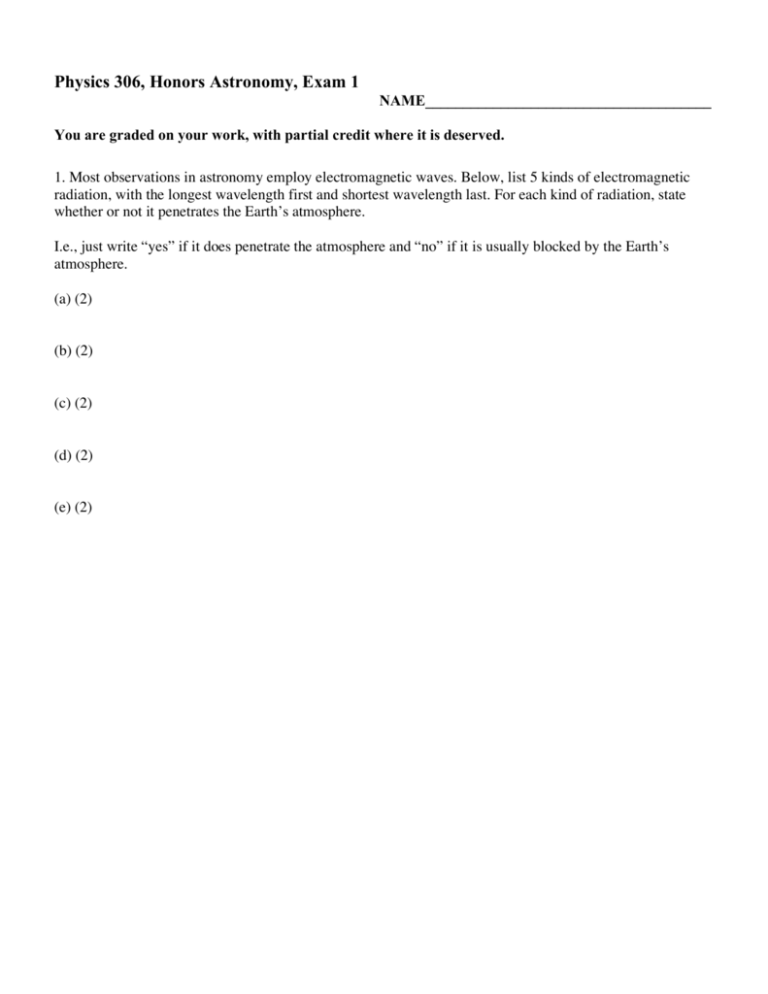
Physics 306, Honors Astronomy, Exam 1 NAME______________________________________ You are graded on your work, with partial credit where it is deserved. 1. Most observations in astronomy employ electromagnetic waves. Below, list 5 kinds of electromagnetic radiation, with the longest wavelength first and shortest wavelength last. For each kind of radiation, state whether or not it penetrates the Earth’s atmosphere. I.e., just write “yes” if it does penetrate the atmosphere and “no” if it is usually blocked by the Earth’s atmosphere. (a) (2) (b) (2) (c) (2) (d) (2) (e) (2) 2. (10) Here is a test of both your astronomy knowledge and your communications skills: You are asked to explain to a normal 8-year-old child, drawing simple pictures, why it is hot in the northern hemisphere during the summer, and cold during the winter. Do this below, using clear sentences and drawings that an 8year-old would immediately understand. (Not clear and understandable to 8-year-old => low grade.) 3. (10) Now let us advance to a normal 16-year-old. Using clear sentences and drawings that a 16-year-old would immediately understand, explain the origin of the tides. (Not clear and understandable to 16-year-old => low grade.) 4. (10) Suppose that you become an astronaut, and at some time in the future you are approaching Mars for a landing. With your cellphone, you call a friend on Earth. Assume that your friend responds immediately to your call, and there is also no delay in the electronics, so that the time which goes by after your saying “hi” and your hearing “hi” back from your friend is just equal to the time required for light to travel from Mars to Earth and back. If Mars is 100 million kilometers ( 1.00 ! 10 8 km) from Earth at this time, how much time goes by before you hear your friend’s reply? The speed of light is 300 million meters per second ( 3.00 ! 10 8 m/s), and 1 kilometer = 1000 meters. 5. (a) (10) The supergiant star Betelgeuse has a measured angular diameter of 0.044 arc-second. Its distance has been measured to be 427 light-years. What is the actual diameter of Betelgeuse in kilometers (km)? Note: 1 light-year = 9.46 ! 1012 km and ! d " ! 360 2# D ! where ! is the angular size in degrees (with 1 = 60 arc-minutes = 3600 arc-seconds), d is the physical size, and D is the distance. (b) (5) The radius of the Sun is 695,000 kilometers: R! = 6.95 ! 10 5 km. Calculate the radius of Betelgeuse compared to that of our Sun. I.e., calculate RBetelgeuse R! , where RBetelgeuse is the radius of Betelgeuse. 6. (10) You are an astronomer on Princess Lea’s home planet. (Ignore the fact that your planet will eventually be blown to bits by Darth Vader.) You know that, on a particular day, your sun is directly overhead (i.e., 0 ! below a vertical line) in the town of Sandville, at exactly the same time that it is 10 ! below a vertical line in the town of Waterville. If Sandville is 1000 km from Waterville, what is the radius of your planet? (Hint: If you draw the relevant picture, you will get an equation that is very similar to that given in Problem 5, but with d and D having different meanings.) 7. (a) (5) Briefly explain the origin of the famous 21 cm (21 centimeter) line that is used to observe neutral hydrogen gas in astronomy. (b) (5) What element was discovered in the Sun before it was found on Earth, and what was the “fingerprint” of this element which was different from the “fingerprints” of all known elements, proving that it was indeed a new element? (c) (5) Briefly describe two different methods used by astronomers to separate the colors – i.e. wavelengths – of the light coming from a star or other object. 8. (a) (4) Briefly describe the Doppler effect. (b) Very briefly give 3 applications in astronomy of the Doppler effect. (i) (2) (ii) (2) (iii) (2) 9. (10 – and up to 10 more for extra credit if extraordinarily good in vision, substance, and style) In a few sentences, discuss the future of the human race. Have a good weekend!


